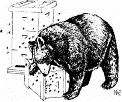Vertebrate Pest Conference Proceedings collection
Date of this Version
February 1982
Abstract
Cliff swallows (Petrochelidon pyrrhonota) nesting in colonies on man-made structures can cause aesthetic problems and health hazards. Cliff swallows are migratory, wintering in South America and breeding throughout most of North America. Cliff swallows have a homing tendency to old colonies and are attracted to the gourd-shaped mud nests. Egg laying begins before nest construction is finished; clutch size averages 3 or 4 eggs. Re-nesting is common if a nest fails and some pairs may raise 2 broods in 1 nesting season. Cliff swallows may be present at a colony for up to 132 days. Cliff swallows are protected by the Migratory Bird Treaty Act of 1918, and a permit from the United States Fish and Wildlife Service is required for certain control activities. Successful control methods include nest removal by water hose or a pole, and exclusion using netting, poultry wire, or strip doors. Nest substrate modification is successful in some instances. Methods employed with little success or that remain unproven include metal spines, repellents, frightening devices, predator models, taped alarm calls, and a fresh coat of paint. Attention to architectural design may alleviate cliff swallow nesting problems.

